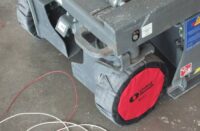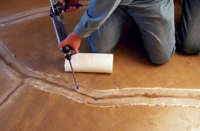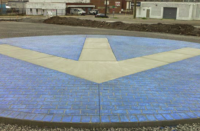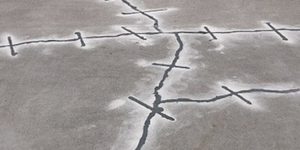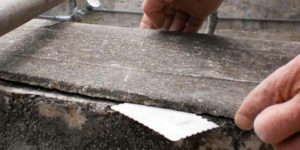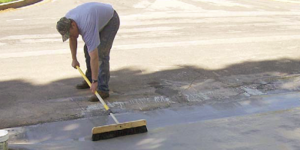It was not your best-case scenario.
A new Army/Air Force main exchange, an indoor mall with multiple vendors and a food court, was slated to open at Fort George G. Meade in Anne Arundel County, Maryland, in six weeks. The floor had been ground and polished, the racks staged and the food vendors’ equipment installed.
Problem was, as soon as the floor was cleaned of all the construction debris in preparation for workers to start moving heavy equipment across the exchange’s shiny new 110,000-square-foot floor, a large amount of “craze cracking” became apparent. This type of cracking is caused by rapid shrinkage of the surface, forming crack patterns across it that looked like spider webs. While all concrete cracks this way to some extent, these cracks were larger. This was a potential indication of a much larger problem where delamination was occurring at the surface of the slab.
The Army-Air Force Exchange Service project manager called David Stephenson of Polished Concrete Consultants in Dallas, Texas, to assess the situation. Stephenson found the problem was not confined to just a few places; it was widespread. The paste cap was separating from the body of the concrete below.
“It appeared that bleedwater was trapped at the surface by the finishing process,” says Stephenson. “This created ‘blisters’ just below the troweled concrete paste layer which is between 1/8 and 1/2 of an inch below the surface. As we reviewed the project, we found thousands of delaminations ranging in size from 10-feet square to just a few inches in diameter.”
“If you dragged a chain or steel rod across the floor, you could hear that it was hollow underneath,” says Brad Padgett, president of Norris, Tennessee-headquartered Perfect Polish, one of the largest contractors in the U.S. that specializes in polished concrete. “The average depth where the separation occurred was 1/8 inch under the paste cap.” To remediate the problem, his company was hired to remove the entire paste cap and get below these hollow spots before taking the floor up to a 1,500-grit shine. And they only had six weeks to accomplish the task.
Tons of work
For starters, Perfect Polish had to remove the cap with such finesse it didn’t damage the concrete its crews were then going to polish. “We didn’t want to fracture the aggregate or pull it out of the floor,” says Padgett, so big equipment wasn’t an option.
He decided to first use BMC 335s, milling machines from Diamatic that employ 70 to 80 12-inch saw blades stacked side by side, to cut the floor. “They leave a very smooth profile that resembles corduroy,” he explains, with slim high spots and about a 1/8-inch gap between blade cuts. While some areas of the floor required only one pass, the bulk of it required multiple passes to expose aggregate from 1/4 to 3/4 inch in size.
Padgett says they had three roto-millers running two 10-hour shifts each day with between 11 and 14 men per shift. “We removed 50 tons of concrete off this floor,” he says, filling up a full-size construction dumpster every 24 hours.
After the floor was roto-milled, the crews switched to large floor grinders from Concrete Polishing Solutions equipped with metal-bond diamonds to smooth the corduroy profile. With a fleet of eight G-320D propane planetary grinders hooked up to CPS dust extractors to keep the airborne dust in check, they ground the floor with 16-, 40-, 80- and 150-metal-bond diamonds. They then densified the floor with Consolideck LS by Prosoco before polishing it with Sektor pads, a brand-new technology from CPS.
“CPS provided us with 100, 200, 400, 800 and 1,500 resin-bonded diamonds,” Padgett says. “It was the first project this size these (flexible resin-bond diamonds) had been used on. It made a huge difference in speeding up production. Because of them, we were able to hit the very aggressive schedule we’d been given.”
Perfect Polish then sealed the floor with Consolideck LSGuard from Prosoco before embarking on the final step, a high-speed burnish with 3,000-grit Spinflex diamond pads.
No shortage of challenges
The timeframe the company had, from bidding to commencing work, was somewhere between 10 days and two weeks, which isn’t a lot of time to pull together all the needed resources and report for work, Padgett says. Add into that mix the hassle of getting 30-some men through the military security clearance rigmarole so they could get on base. “It was a very stringent background check,” he says, and a major hurdle to clear.
Once they got there, they had six weeks to remove 1/8 to 1/4 inch off the top of the 110,000-square-foot floor and bring the floor up to a beautiful polish. “Working inside a finished building with a very elaborate roof and lighting system was a challenge from the very beginning,” Padgett says. “We had plastic hung across everything and were basically in a plastic cocoon the entire time we were working to keep the dust from getting on the fixtures, the windows, the painted walls.”
To keep the lines of communication flowing between the crews that worked the day and night shifts, a 20-minute safety and communication meeting was held each day when the shifts turned over. “This way, the incoming crew could pick up where the previous crew left off without having confusion,” Padgett says. And, he’s proud to report, “We had zero safety issues on this project.”
As a quality control measure to ensure they removed a minimum of 1/8 inch from the surface, Perfect Polish ran east to west saw cuts every 30 feet. “We used a micrometer to make sure we had the depth of the saw cuts right,” Padgett says, and spraypainted the grooves in the floor with white paint. The crew then ground in a north to south pattern. “Once we had ground through the spray paint we knew we had ground enough off and could start the polishing process,” Padgett says. Without the spray painted guide lines, he adds, “Trying to determine when we had ground off 1/8 inch could have been really tricky.”
Project at a Glance
Client: Army-Air Force Exchange Services
Project: Main exchange at Fort Meade in Anne Arundel County, Maryland
General contractor: Walbridge Construction | www.walbridge.com
Polishing contractor: Perfect Polish in Norris, Tennesse | www.perfectpolishconcrete.com
Consultant: David Stephenson of Polished Concrete Consultants, Dallas, Texas | www.polishedconsultants.com
Scope of project: A 110,000-square-foot floor was poured and polished prior to Perfect Polish’s involvement with the project. The company was hired to fix a problem with the paste cap separating from the body of concrete.
Products used: onsolideck LS densifier and LSGuard sealer by Prosoco; Spal-Pro RS 65 joint sealer in Porpoise Gray by Metzger/McGuire; Spall TX3 grout coat by Hi-Tech Systems; and Concrete Polishing Solutions’ Red Shark edge grinding discs, Speedline edge polishing pads, HFL metal bonds, T3 transitional diamonds, Sektor polishing pads and Spinflex diamond burnishing pads.
